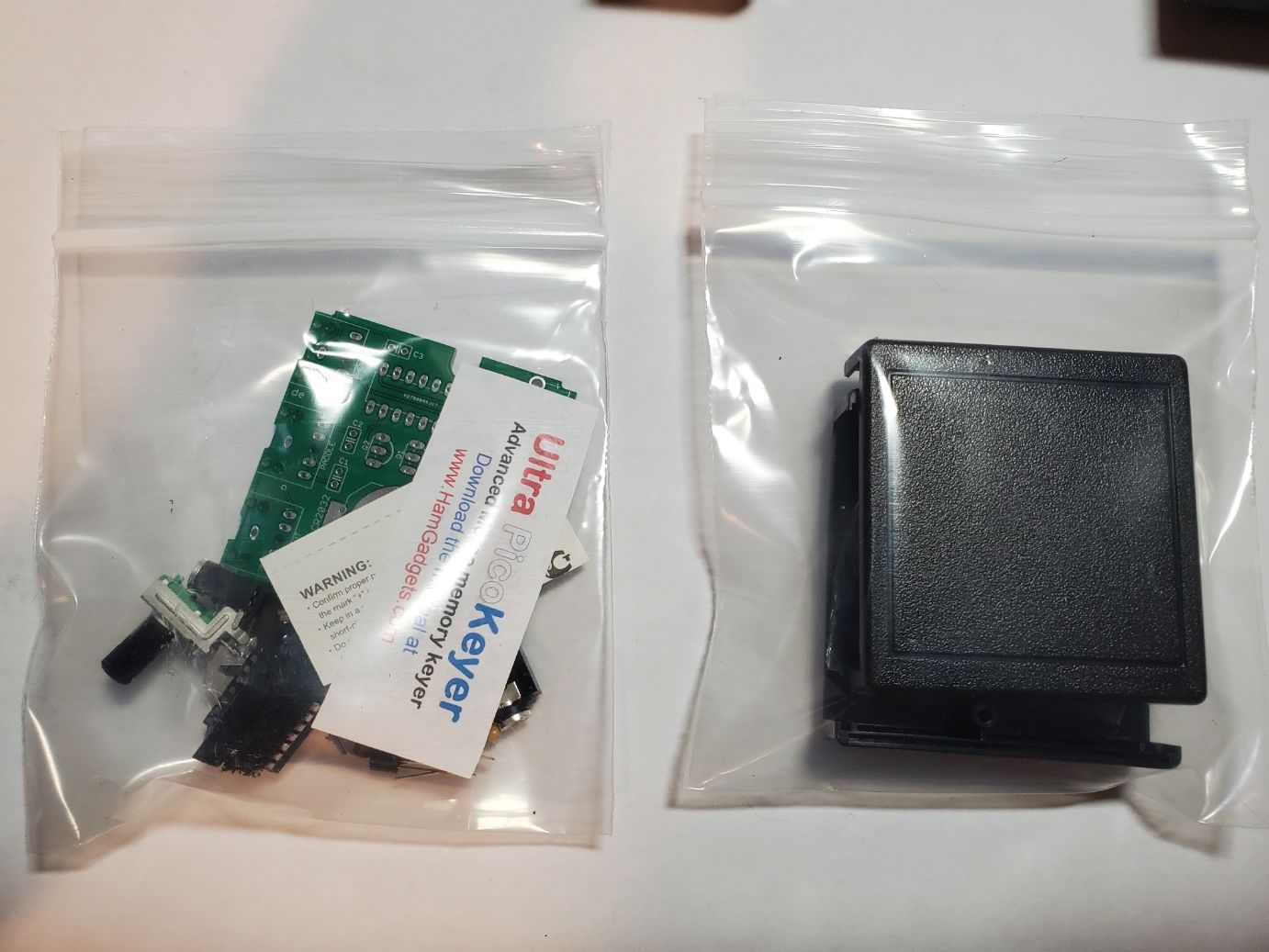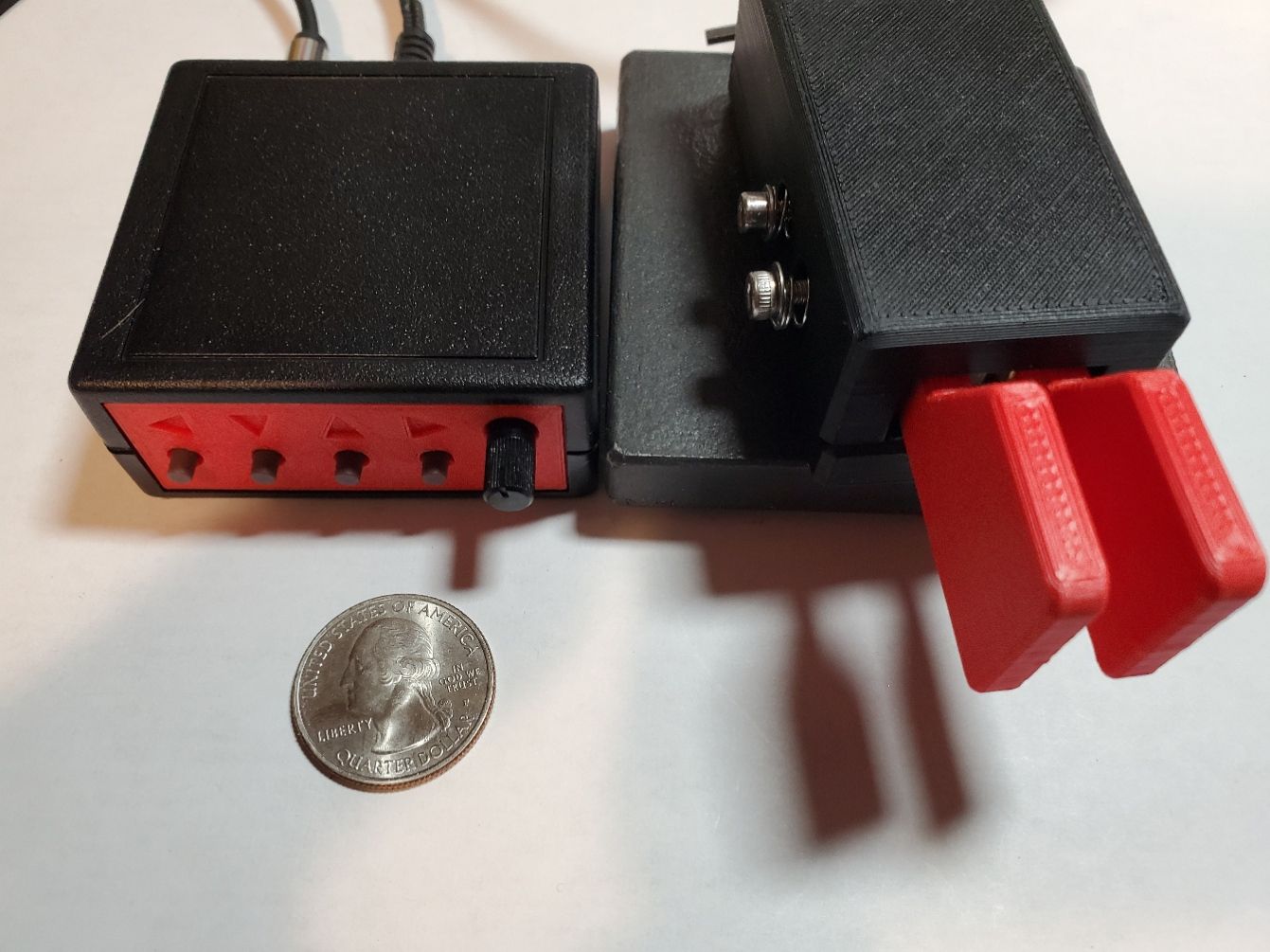HamGadgets Ultra PicoKeyer Kit Build and Review

One of my goals for this year was to become a more capable CW operator and be able to have a valid POTA activation using nothing but Morse code. While I haven't activated solely with Morse code as of this writing, I did get 11 contacts during my activation at Theodore Roosevelt Island on 5/28/2022, which would be a valid activation if taken by itself. I was able to hit this milestone well before I thought I would be able to, which surprised me. What surprised me even more is how much I enjoy working CW. While I have a straight key, I've found that I enjoy using an iambic key for operating as it does a great job at keeping the code I'm sending consistent and on-speed. For portable operation, my Icom IC-705 has a built-in keyer that does a great job, but for my older Kenwood TS-440S that I use at home, I need to use an electronic keyer in tandem with the key to get my code on-the-air.
To that end, I had been using the Morserino kit that I reviewed earlier. It does a great job as a keyer (as well as being great for code practice and echo training, along with many other features), but it has one feature that makes it difficult to use as a dedicated keyer. After a period of inactivity it shuts itself off to preserve battery life, even if it is plugged-in. After having it shut-off in the middle of a couple MVARC CW Roundtables right before my turn to send, I decided I needed a dedicated electronic keyer. Thankfully, Thomas (K4SWL) had a write-up of an activation at QRPer.com where he was using a Yaesu FT-817ND without a built-in keyer and was using the HamGadgets Ultra PicoKeyer. It looked like a great solution, so I went on over to eBay to order one for $44.95 plus tax and $5.95 in shipping. Since my purchase the price appears to have gone up about $5.
I ordered on June 9 and it was at my door June 13 via the US Postal Service. It was well packed inside a cardboard box filled with two poly bags containing the parts and a case. Some newspaper served as padding inside the box and everything arrived as expected. I went to the HamGadgets site to download the instruction manual, did a quick inventory of the parts, turned on my soldering iron, and got down to business.

The build itself was very straightforward and consists entirely of through-hole components. I was able to finish the entire build in about an hour of relaxed assembly. The instructions were clear and easy to follow. The only hiccup was that the instructions mentioned a few capacitors that were supposed to be on a paper holder that were loose within the poly bag. There are a couple different types of capacitors in the kit, so I needed to inspect the labels on them to ensure I was installing the right ones. Thankfully, the needed information was on the instructions, and after a little squinting, I was able to identify which ones went in what places. In all there is a coin cell battery holder, 3 x 3.5mm (1/8th inch) stereo jacks, 4 momentary push-button switches, a potentiometer, 2 transistors, 3 capacitors, a small speaker, and a microcontroller chip with a DIP socket to install. There are multiple capacitors provided so you can tailor the sound level of the headphone output, depending on the impedance of the headphones you would like to use. When you're done with the circuit board build the moment of truth comes when you insert the CR-2032 coin cell battery (provided). If everything is wired up properly, the on-board speaker sends "73" on power-on. Happily, I was greeted with a cheerful "73" and everything worked the first time.

With the circuit assembled, it was time to put it into its case. When you buy the kit from eBay, they mention that there are 6 colors available for the front and back panels (black, white, blue, gray, green, and red). There isn't a check-box, so make sure you put in as a message to the seller on check-out or you'll get the default color of black. I requested the red panels and they fit the case snugly. They look to be 3D printed with recessed labels for the buttons and jacks. The case itself appears to be injection molded plastic and is held together with a couple screws that are provided. Once it is together it makes for a handsome little box that is quite small (a photo below shows a quarter for scale alongside my CWMorse Pocket Paddle).

Once it is all together, the unit is ready to be connected to your paddles via a 3.5 mm stereo cable (not provided). 3.5mm jacks are also provided for a pair of headphones (without volume control -- that's why the capacitor selection is important) and to control the key input on your rig. By itself, it works as a practice oscillator, and teamed with your radio you're ready to transmit. Out of the box the key speed is set to 13 words per minute if the potentiometer is fully counter counter-clockwise. Otherwise, the potentiometer allows you to change your speed between two values that you can set -- by default the range is 5-30 WPM, but 5-60 WPM is supported. The full left rotation setting is also able to be set, so you can set a favorite speed for the far left rotation, then QRS or QRQ as needed. Although the potentiometer is analog, the actual setting is digital. If you would like to know what speed you are sending pressing the buttons for ▼ and ► together (the second and fourth buttons) will send the current speed in Morse code over the internal speaker.
Pressed by themselves, the four buttons act as memory keyers. They are easily set by pressing the button until a "K" is sent through the speaker. Then key the message desired into memory, press and hold the same button, and when you hear an "R" you're done. To abort, press any other key instead. Short pressing the key will now send your message at the current speed. This is very helpful for sending a CQ message repeatedly, as well as for sending your call, or a contest exchange. There is even an option to use a QSO counter for contests that have a serial number in the exchange that gets incremented during each QSO. The memories even have their own scripting language of sorts to allow for words to be repeated, pauses to be inserted, QSO numbers to be incremented, speed to be changed, and for things like QRSS to be done. The repeats can be especially helpful as the memories themselves are limited in length, so using the scripting commands (using the / character) allows you to get more out of the memories. Each of the 8 main memories can contain 127 characters. They can also be chained together using the commands. There are 4 messages readily accessible, and in the settings menu you can move to a second bank if desired, but this is not something you'd be able to do quickly during a QSO.
There is also an extensive setup menu (entered using the ▲ and ► key combination -- buttons 3 and 4) that uses Morse code to communicate with you to announce the feature, its current value, and then allow you to modify it using the buttons. I found most of the defaults to be satisfactory, but you can modify the stored speed for the fixed speed, the QSO number, set the range for speeds on the potentiometer, enable or disable automatic letter spacing, enable or disable leading zeroes for the QSO numbers, set a beacon delay, change the weight for the code being sent, enable or disable the sidetone, choose your keying mode (iambic A, iambic B, and Ultimatic are supported as well as a straight key mode and a bug mode that simulates a bug style key), choose which side on your paddle is a dit, what frequency the sidetone is sent at, which bank to use for memories, and whether to have the menu send long titles for each menu item.
It is quite full featured for something that is so small. HamGadgets says that in normal usage the battery that is supplied should last about a year. Within a few seconds of inactivity the microcontroller for the unit goes to sleep to save power, but hitting a button immediately wakes the unit and performs the requested operation. For the end user, the effect is that the unit is always "on" and ready for use while being power efficient.
It is not without its faults, although the ones I have found are fairly minor. The speaker on the unit is not very loud, especially inside of the provided enclosure. If your primary use is for a code practice oscillator for use without headphones, this may be a problem. I use it as a keyer for my rig, so that isn't an issue for me, but it is worth noting. The lack of a volume control for headphones may similarly be an issue. The volume is adjustable by changing the soldered capacitor depending on the impedance of the headphones, but it is not able to be changed in normal use. A passive headphone volume control could be added if attenuation is needed. Some users may be unhappy with the default sidetone frequency of 2,000 Hz (700 Hz is the standard for most similar devices). The sidetone can be changed in a menu setting, but the manual suggests keeping it at 2,000 Hz as that is where the supplied speaker has peak loudness. Considering how quiet it is at 2,000 Hz in the case, I've elected to keep it where it is, although I do wish it was closer to 700 Hz. That said, when operating my rig, I hear its sidetone through my headphones, so the speaker isn't necessary for on-the-air usage. The menus are fairly involved, and to use them successfully you must know Morse code as there is no display. That said, the documentation is thorough and easy to follow and if you're buying a CW keyer, you probably already know or are in the process of learning Morse code, so that's not likely to be an issue for long. Finally, although long-lived, the reliance on a coin cell battery inside of a case with a screw enclosure means that if the battery dies while away from the shack, it isn't easy to change in the field.
I've been very pleased with the HamGadgets Ultra PicoKeyer. As a kit, I would say that the Ultra PicoKeyer would be suitable for beginners. If you can make a basic solder joint, this kit is easy to build and hard to mess up. As a keyer, it does a great job in a compact and inexpensive package that is power efficient and easily portable. The memory keying features make it a great companion on-the-air, whether calling CQ, activating a park on POTA, or working a contest. It was fun and quick to build and works well.

